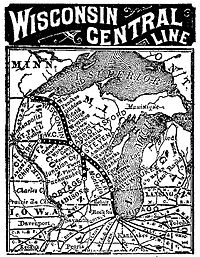Wisconsin Central Railroad (1871–99)
 |
|
| Locale | Wisconsin, Minnesota, Illinois |
|---|---|
| Dates of operation | 1871–1899 |
| Successor | Wisconsin Central Railway (1897–1954) |
| Track gauge | 4 ft 8 1⁄2 in (1,435 mm) standard gauge |
The original Wisconsin Central Railroad Company was a major early railroad of northern Wisconsin, building lines up through the forested wilderness, and opening large tracts to logging and settlement. It established stations which would grow into a string of cities and towns between Stevens Point and Ashland, including Marshfield and Medford, and it connected these places to Chicago and St. Paul. It played a major role in building Chicago's Grand Central Station.
Despite these successes, it struggled financially from the start and was bankrupt by 1879. It was leased to the Northern Pacific Railway from 1889 to 1893 and was finally reorganized from bankruptcy in 1897 as the Wisconsin Central Railway.
By the time of the Civil War the southern half of Wisconsin was somewhat settled. Much of the north, however, remained wilderness, including swaths of beautiful virgin timber and deposits of iron ore. Treaties with Native Americans had placed most of this land in the hands of the federal government. Logging of the white pine had begun along the rivers, where the product could be floated out, but some stretches of timber stood far from large enough streams for river-logging. One such stretch lay between the Chippewa and Wisconsin Rivers
At that time, U.S. feelings toward Great Britain were not as warm as today. Britain was officially neutral during the Civil War, but many of the British elites sympathized with the Confederacy. This was only 50 years after the War of 1812, in which Britain had captured Prairie du Chien, among other indignities. And it was less than 100 years after the American Revolution. The British Province of Canada lay just across Lake Superior, and the War Department wanted the ability to move troops and supplies to that border, just in case. Toward that end, the government cut military wagon roads through the northern forest. These were financed in part by land grants, where the government gave the road-builders timber and land close to the roads. But these stump-choked wagon roads would have transported war materials very slowly, so in 1864 the U.S. Congress offered similar land grants to encourage several proposed railroad-building projects from Portage up through the center of the state to Superior. Generally, if a railroad was built of adequate quality, its company received half the land and timber for ten miles on either side of the segments built - the odd-numbered sections.
...
Wikipedia
